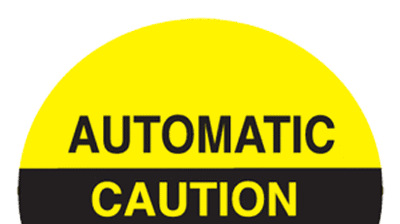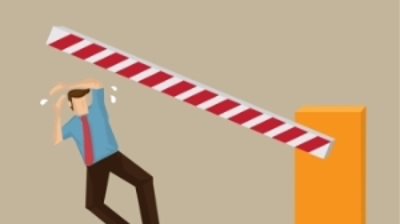Automatic Doors
&
Daily Safety Inspections
Why they are Important & How they Protect Pedestrians
By Michael Panish
Automatic Door Expert Witness
Download PDF of this article here
Why are daily safety inspections of automatic doors necessary?
When an automatic door system is turned off (store closing) and then reactivated (store opening), there is no guarantee that every component is properly operating or that the door control is correctly interpreting sensor information.
One of the easiest ways to understand what can go wrong with automatic door systems is to equate the various components to familiar human body parts.
- Door sensors are the eyes of the door.
- The cabling that connects the sensors to the door control is like our optic nerve.
- The door controller is like our brain.
- The motor is like our muscles.
Like human eyes, several physical components need to be properly connected and functioning. In the case of a person, it is possible to have a perfectly functioning eye, but still be unable to see. There is an optic nerve (signal pathway) which takes the sensory input from the eye and attempts to transmit it to the visual cortex receptor points in the human brain. If the optic nerve is damaged or impaired in some way, it is possible that no information gathered by the eye will be sent to the brain, so a properly functioning eye can still leave a person blind if the transmission line is defective. Additionally, if brain receptors are unable to process the transmitted information, or there are defects in the cognitive abilities of the persons brain, there is a chance that the person will not be able to interpret the information being delivered by the optic nerve which results in a person with a perfect eye being unable to see.
Automatic door sensors (eyes) can have several defective issues that stop the door control (brain) from receiving or properly interpreting their sensory output. As with human eyes, the sensors can function as they should, but the cable (optic nerve) or signal pathway has some defect that hinders the output signals prior to reaching the door control (brain). The door controller or “brain” of the system has to recognize, interpret, and process the activation or presence detection signals sent by the sensors and send proper information to the motor to open or hold open the door when the zones of coverage are occupied or obstructed.
There are two basic types of sensors used in common automatic door systems. One type is activated by motion and is sometimes referred to as an approach sensor. These types of sensors can be individual units or part of a combined sensor (motion/presence) product. They rely upon various technologies using radar-like pinging. Sometimes they are infrared, other times they are microwave. The motion detection sets up a chain of mechanical responses that allow a pedestrian to walk through an open doorway before reaching the threshold. There are minimum activation distance requirements that must be met to be standard compliant.
The second and most important sensor on all automatic door systems is the presence detection or proximity sensor. According to industry standards, once an automatic door is activated, there must be full and complete overlapping zones of protection between the activation point, through the transition across the door threshold, and out the other side of the door so that a pedestrian is observed and protected by these sensored safety zones of coverage. If a doorway is open, and a pedestrian moves through the threshold, the presence detection sensor must hold the door in the open position, even if the pedestrian stands motionless on the threshold for thirty seconds. It is almost impossible for most people to remain motionless, and as a result of that, a properly adjusted and aligned presence detection sensor will hold the door open endlessly.
There is also a timing device built into most door controllers that allow the door motors to operate once there is a “loss of signal” from the sensors. In other words, after a door controller “Polls” or verifies that all the installed sensors have reported an “ALL-Clear”, the door controller sends a signal to the motor to allow the doors to move to the closed position.
On all modern sensors there are multiple emitters and receivers that are used to interpret a pedestrian or other stimulation within the zone of coverage. Frequently, some of the sensor components become misaligned, intermittently malfunction, or partially burn out which leads to lack of information being sent to the door control brain.
On certain presence detection sensors, they may have multiple emitters that attempt to provide comprehensive coverage over a threshold. If you position your hand with all five fingers spread apart pointing down and outward toward the floor it is possible to envision how the multiple beams of a presence detection sensor can be positioned.
If you bend, lift, or move your fingers into other positions where they are not pointing directly downward or left or right, you can also observe how a misaligned sensor emitter can be maladjusted to not fully cover the entire area as originally planned or required by standards.
In other cases, the “brain” of the door cannot recognize all of the sensory input and fails to “realize” that there is a pedestrian obstruction. This is one of the common causes where pedestrians are struck by closing doors while they are crossing the threshold.
There are recognized defects in some control modules (brains) that require close scrutiny by the owners of these door systems. It has been observed that anytime the power is interrupted to the door system, all of the safety systems need to be evaluated for proper operation and function. One control module in high use in the industry has been repeatedly found to lose sensory input information and without verification it appears that the door is mechanically correct but does not have the “awareness” of all door sensors. This leads to door impacts with pedestrians if not properly tested and verified each time the door system is activated each day. Manufacturers provide information in their owner’s manuals that instruct, inform, and attempt to teach the end users about the necessity of making “daily safety inspections” of their doors, but even with applied warning labels placed near the activation switches, many door owners fail to heed those words and warnings.
There are many reasons that pedestrians are struck by automatic doors, however in the majority of personal injury legal claims, proactive daily safety inspections would have discovered the malfunctioning sensors or other contributing factors and triggered owners to contact a competent professional service provider to make necessary repairs prior to creating injuries to pedestrians.
This article is intended to make all interested parties aware of the continuous and ongoing need to perform daily safety inspections and improve the safety of all pedestrian automatic door users. This is not a comprehensive analysis or complete discussion of the multitude of automatic door operational concerns, rather an attempt to improve the awareness of the general public that automatic doors need to be appropriately maintained and routinely inspected by the people that provide them for their patrons. All pedestrians should use caution whenever they use any automatic doors.
The automatic door industry, manufacturers, and competent service providers all agree that properly functioning automatic doors are safe and have become commonplace in society. No properly functioning doorway should come into contact with a pedestrian user if the door sensor systems and all door components are fully functional and properly maintained.
For more information and details that are specific to your personal injury case, contact Mike Panish, the nation’s leading automatic door expert. He is retained equally by Plaintiff and Defense and has provided his expert services to door and door hardware manufacturers, service providers and installers in defense of claim. He has provided expert services since the year 2000. For immediate assistance with your claim, whether plaintiff or defense, contact Sharon at 888 902-4272.



